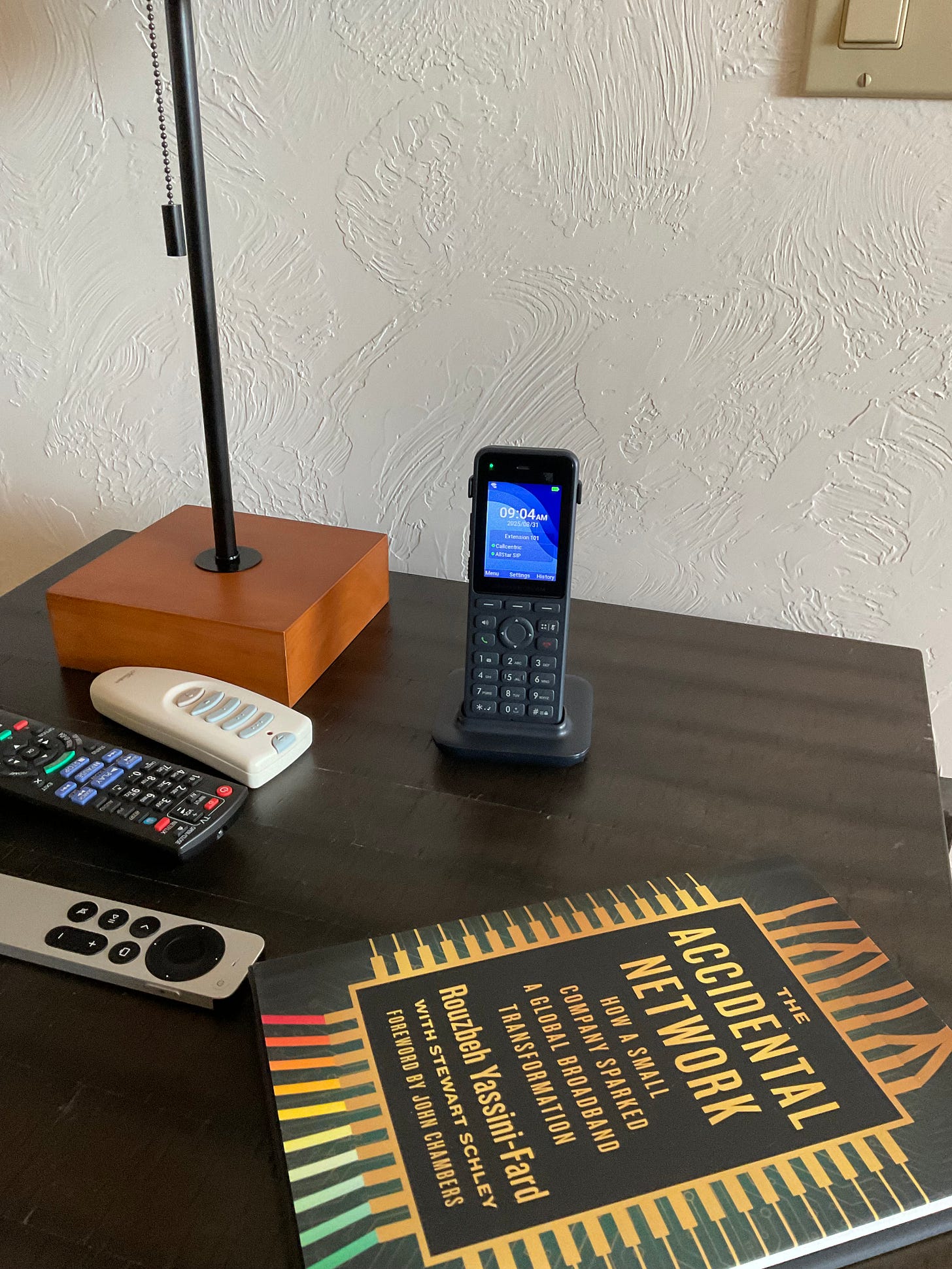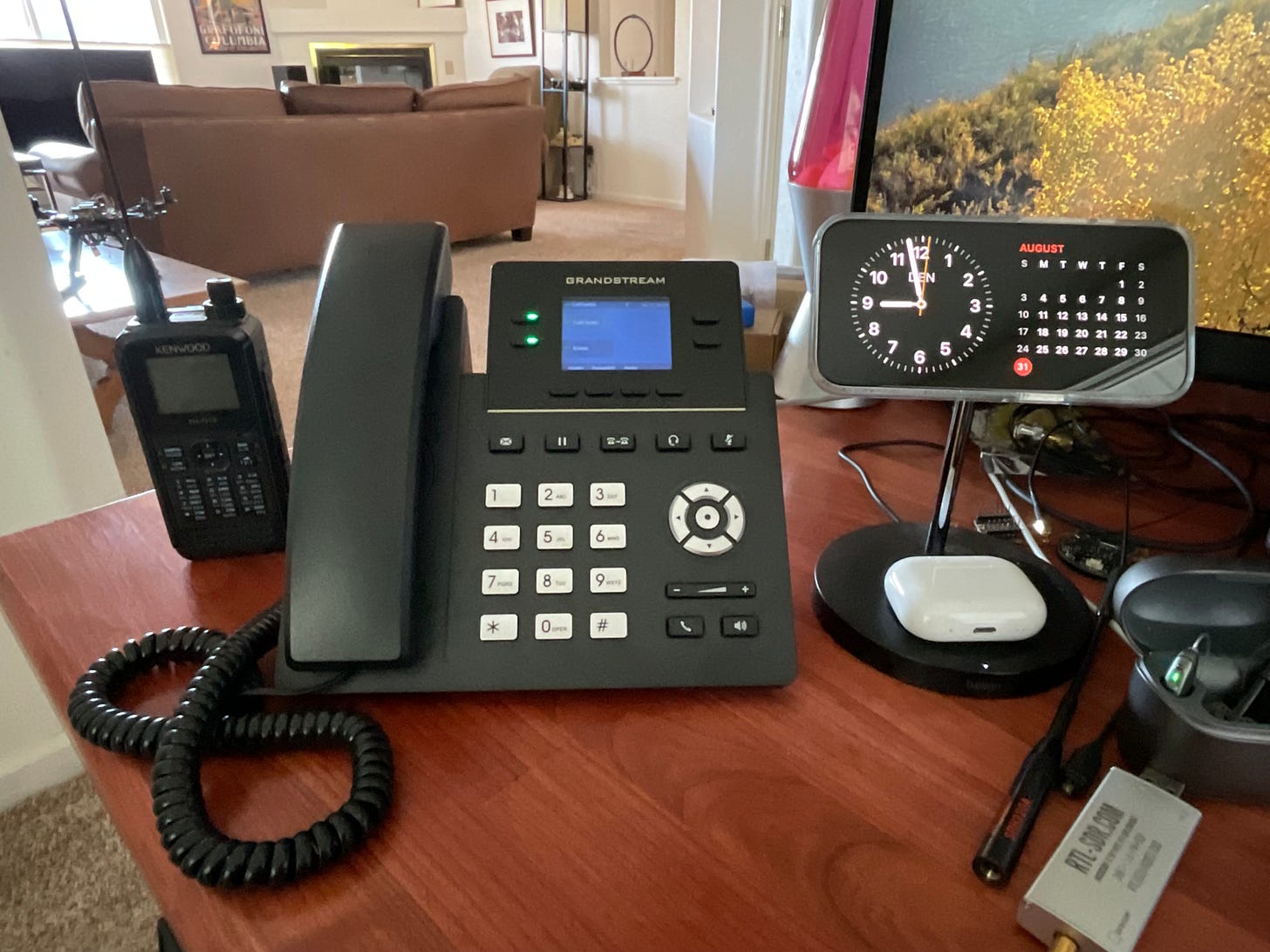AllStar Revisited Part 2
EG Home Phone!
Everyone knows the story: Over the last 20 years the mobile phone has become the primary way people communicate, possibly even more than face to face. The number of phone numbers has exploded, at least one for everyone. In many cases people have several phone numbers, one for their personal phone, one for the work phone, and maybe an office desk phone with extension. Not only that but you have your FaceTime account, Google Voice account, WhatsApp, Facebook Messenger, Skype, Signal, Discord, Linphone… and online meeting apps like Zoom, Teams, Slack, and WebEx. An overabundance of options for reaching out to each other. And because there’s so much fragmentation, we all need all of these apps (with their own accounts, logins, and tracking cookies) just to make sure we cover our bases.
The last thing we need is another phone number. But is that really the case? Do I want everyone to be able to reach me no matter what? How often do we look at CallerID and reject the call just because we don’t recognize the number (or more correctly because it isn’t in our Contacts list -we offloaded phone numbers to “external memory” a while ago)?
And then there’s call quality. If you’re using Bluetooth earbuds and both cellular carriers are using the Adaptive Multi-Rate Wideband (AMR-WB) codec, call quality over a mobile phone is very good. But if the Wideband handshake doesn’t happen the calls drop down to G.711 µ-law, which sounds pretty bad compared to AMR-WB. Or switch to the minuscule handset speaker with the mic right next to it (and all the feedback suppression algorithms), and all that tech fails thanks to physics… because there’s just no good way to move enough air in a 7mm thick case to make calls sound good.
Remember calling the family instead of individuals? After the Carterphone decision the number and variety of handsets exploded. People were putting phones in every room, and it was common for mom to shout to the rest of the house to pick up the extension so everyone could participate. Try doing that today. OK, hang on while I try to conference your dad in… Three way call, dad picks up… push the “join” button. Easy right? Then why doesn’t it work very well? Why don’t people do it more often? And what happens when you want to add a 4th caller? And if there’s any glitches in the call the whole thing collapses.
In part one of this series I described the current state of ASL3 and my efforts to get linked up to the AllStar network. This post is about the “second line” I set up for connecting to the public switched telephone network (POTS).
It’s All In The Clouds, Man
Just like everything else that’s gone digital, office phone systems have gone up into the cloud. Anyone can get a virtual PBX in a matter of minutes by just signing up with one of the many VoIP providers. These aren’t just normal phone lines either. You can buy incoming only, outgoing only, flat rate incoming and paid by the minute for outgoing, and free calls between other VoIP providers. And any number of add-ons including cloud voicemail, forwarding, texting (if your phones support it) and you can get a “local” number anywhere in North America. I went with Callcentric because they have several home options that are priced pretty well. After a few minutes and a few dollars I had a VoIP phone number. A couple of minutes later I had 3 extensions set up. Programming the handsets was simple too, just follow along the guide.
Finally I had the phone system I had thought about all those years ago. It even has paging and a “push to talk” feature that will broadcast (technically multicast) voice over all the phones in the house (which also works with ASL3 with some advanced configuration). But again, why? Well, why not? It’s kind of nice having a good speakerphone on my desk. The phones are inexpensive and didn’t require a lot of wiring or set up. And it’s a cheap backup for my iPhone.
The cool thing about putting it all in the cloud is that I can take the handset with me, and anywhere there’s a network connection the extension will work. This is how virtual call centers and work from home systems are able to route calls to workers who aren’t in the office. Or I could send handsets to friends and family and we could contact each other by extension, for free. And in the case of mobile phones, there are apps that act like VoIP handsets that become just another extension. Adding calls isn’t quite as simple as “Hey honey, pick up the extension!” but with preprogrammed soft key buttons you can get pretty close.

Again, why bother? Well, because it’s geeky cool, that’s why. Sure my mobile phone does all that and much more, but someone else does all the work. I had to figure out how to provision the handset, set up the accounts, add the features… and I could pick and choose exactly what I wanted to pay for, not just pay for “unlimited” service that cuts off after some arbitrary amount of minutes or Kb are used.
Going a step further, how about an auto patch for my repeater? Talk about retro-telephony! There are still plenty of places in Colorado where phones don’t work but amateur radio will. It could be a very inexpensive add-on for ASL3 repeaters and might generate a little activity too. And in an emergency do you want to trust that someone is monitoring the club repeater? Given the activity on most repeaters these days I wouldn’t bet on getting through to someone in an emergency. But with a VoIP phone patch at least you can phone a friend or 911.
If all this sounds like a good way to spend a weekday evening or two, you can set up a free Callcentric account. Full disclosure: that link uses my affiliate code, so I’ll get a small commission if you sign up for any paid services. As for hardware, I really like Grandstream handsets (watch for returns and used on Amazon -the desk phone was $23 and looks brand new), but there are plenty of other options worth investigating. And there’s always software and apps that are free.
I often wonder if we were a little too hasty dropping home phones. Of course we all hear about the downsides of being connected all the time (because the old legacy media companies want to go back to the 90s when they ruled the roost), but I also think there’s something to be said for having a family clearinghouse, a “home base” that is familial. And if you just want to talk to someone from a group, doesn’t matter who, maybe a group number is a good thing. The alternative is a sequence of call, no answer, call, no answer, call, no answer until you either give up or start leaving messages. Imagine calling one number and whoever picks up is who you talk to.
In part three I’ll finally get the D-Star repeater talking AllStar, and get some radios in the loop.



